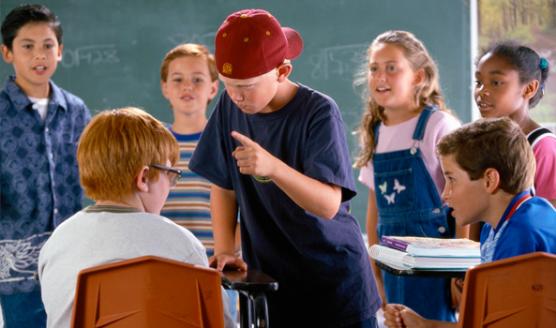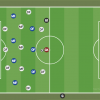I was 12 when I helped my NCAFA team, the Orleans Bengals, put together an off-season program aimed at helping kids like me (bullied, angry and socially isolated) develop stronger social skills and a sense of community – both of which are key protective factors to help young people cope with bullying.
I had no idea what I was doing, neither did my mother who was helping administer the program and interestingly enough, my coaches didn’t know exactly what do to either.
Football coaches are in charge and direct their players with authority and command respect and discipline on and off the field. Direction usually starts at the top, with the head coach, filters to the coordinators, down to position coaches and finally to the players. So imagining a scenario where coaches shared program design, development and control directly with players was not just new, to some it seemed like the apocalypse was at hand. After all coach’s coach and players learn; why mess with what works.
The answer for the Orleans Bengals (and me) is that millennials are different than our parents and our grandparents. The world we live in is different. The schools we learn in are different. The games we play are different. And even our childhood bullies are different. All this change in such a small amount of time means our parents are not always able to guide us through the minefield of social media and global group think that we face each day.
The response to this different childhood landscape at the Orleans Bengals was to put meaningful youth engagement into practice. It started with the club’s executive’s saying “yes” to my proposal to start an off season program. I wanted a place where other kids like me, those who struggled in school with behavior issues and who were on the outside of the social elite in school, had a place to connect with our football peers. A place to discuss how to deal with cyber bullies (those cowards who use their phones and laptops to bully us from the safety and anonymity of their bedrooms) with more usable solutions. And a place where youth who bully could learn to put their aggression to better use and be included in the solution.
Our program focuses on identifying and dealing with bullying behavior not with eliminating bullying behavior or excluding youth who bully. As a result, our field is open to a lot of players who are either fully reformed bullies or are on their way to becoming reformed. This may seem like a strange approach, but giving youth who bully opportunities to change their behavior and be included in the solution has shown itself to be a powerful weapon in the fight against bullying, even if (when) it causes some difficult situations along the way.
There are some pretty serious challenges to this approach, the biggest of which is dealing with youth who bully and trying to figure out why they are bullying. Why figure out why? Because if we don’t know what is motivating the behavior we can’t help change it. Our schools are full of zero tolerance policies when it comes to bullying, which all focus on eliminating the bully, but not so much focused on the behavior and certainly not focused on trying to understand why the behavior is happening. But understanding why is the only way to give a bully the necessary coping strategies to change their behavior.
For example, I went to school with a kid who had major food security issues at home. He would be angry and disruptive all afternoon – and display some real aggressive bullying behavior. His behavior was not acceptable and he was punished over and over for it but he was hungry and anxious and unable to cope with either. Because the school’s policy was simply zero tolerance, no one was looking at why he has behaving badly, just reacting to the bad behavior. Figuring out why the behavior is happening is the best way to change it.
One of the important parts of the Be A Bengal Not A Bully program is including players in the solution, listening to what we think will work and giving players like me the opportunity to develop leadership skills. Including players helps us identify potential leaders who aren’t given the opportunity at school to shine. Whether these players are marginalized because of poor grades, poor social skills, anxiety, ADHD or learning disabilities, they are left out and their leadership potential at risk of being lost. Since 2008, about 40 players have become peer mentors through our program. Of those 40 peer mentors, only about 5 had strong enough social skills at the start of the program to be included in school run leadership programs.
In 2008, we were able to secure a Dare to Dream grant to cover initial costs (like Dome rental and costs associated with guest speakers). After a couple of building years, we were able to attract the support of local councilor Stephen Blais and with his help were able to bring Taggart Homes on board as a 4 year sponsor for the program. This past year, the program branched out to a Bengals Play 90, complimenting the social aspects of the original program with the benefits of greater physical activity.
Some of the most interesting results of the program have to do with how well the Bengals organization is doing and a purposeful shift in how coach’s coach. Last season (2014) all 5 levels of the club (from Tyke to midget) were represented at Championship week (no other NCAFA team can make that claim). Our sidelines are consistently busy with parents and volunteers making game day a success with a great canteen, 50/50 draws and lots of support and cheering for all our players. In addition to Councilor Blais, Taggart Homes and our title sponsor Myers Orleans, we have many new community partners and sponsorship opportunities with local business. And our coaches are some of the best communicators in the city.
As with most preventative programs it is difficult to say which factor is most responsible for this success. Is it because our non-leaders on the field now have leadership training and development opportunities? Is it the focus on social inclusion that creates an atmosphere where families can step forward without shame if they need help paying fees? Is it that meaningful youth engagement means listening, truly listening to one another, so coaches and players are communicating better than ever – on and off the field? Is it because reformed bullies and all their now controlled aggression now have the focus to really be able to make a difference in a game? Or is it a delicate combination of these and a 100 other factors that creates success.
We still don’t always know what we are doing but we have learned some very important things along the way:
- We are not perfect. Our coaches are not perfect. Our program is not perfect.
- Bullying still happens. At school. At the field. In the community. And sometimes at home.
- Focusing on bullying prevention rather than bullying elimination is the real strength of our program.
- Marginalized, at-risk youth make amazing leaders if you give them a chance.
- The stronger the voice of the players in any part of your program, the stronger the entire program becomes.
- Continued community involvement, from local politicians to community businesses, is essential if we are going to succeed.
An adult is formed slowly, we take lessons from what we learned in childhood, the experiences that we had, the feeling that we felt and we gradually turn into the person we want to become.
The Orleans Bengals gave me an opportunity to grow from bullying victim to advocate. Although we don’t have all the answers and take some pretty unusual angles along the way, we are committed to trying; committed to learning from our mistakes and trying again; committed to listening to each other and trying again.
















